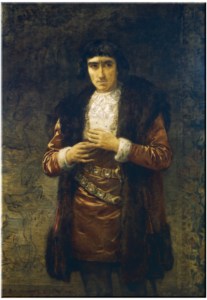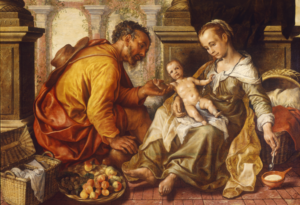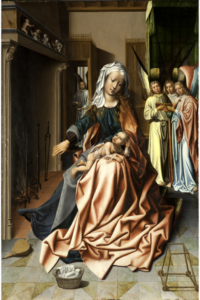Wittenberg, October 31, 1517
Oil on canvas
Eyre Crowe, A.R.A.
English, 1824-1910
Click on the image to learn more about Martin Luther and the Protestant Reformation!
Created by Donnalynn Hess, Director of Education
Published in 2013
Oil on canvas
English, c. 1829-d. 1891

Henry Irving, the foremost actor in England from 1866 to 1902, was the first actor to be knighted for his artistry, which helped raise the social standing of the acting profession. As the premier actor and director of the Royal Lyceum Theatre, Irving produced plays known for their lavish spectacle and melodrama. The expensive productions included the musical talents of composers Mackenzie, German, Sullivan, and Stanford and the literary contributions of Sir Arthur Conan Doyle and Alfred, Lord Tennyson.
Irving’s major achievement was in presenting a play as a unified whole rather than as an excuse to showcase one great talent. In Irving’s productions, the music, lighting, costume, sets, and interpretation of his character all supported the text and the author’s intent. This revolutionary approach to drama gave Irving a permanent place in theater history.
Irving and his leading lady Ellen Terry were especially famous for their Shakespearean roles, and this painting captures Irving in one of his most successful characters. Richard III is the story of an evil younger son who plots and murders his way to the throne of England. Here, the detailed medieval costume of dark, rich fabrics, along with Irving’s nervous gesture and shifting, sideways glance are meant to reflect the evil cunning of Richard’s character and his guilty conscience. Irving’s slight stoop reflects Richard’s physical deformity, described as a “crooked back” with “his left shoulder much higher than his right.”
Portraits of actors in costume were fairly common during the 1800s, and Irving was painted many times—most notably by Edwin Long and Sir John Everett Millais. This painting was one of three from Long commissioned by Baroness Burdett Coutts. When the portrait was exhibited at the Royal Academy of London in 1878, it was considered to be “the best portrait yet painted of the popular tragedian” and a good example of “the skill with which [Irving] made up for Richard after the best authorities for look and action.” Since Irving’s 19th-century audience knew his power as an actor and his association with this character, they would have easily understood the portrait’s significance; understanding the context increases our own appreciation today.
Published in 2013
Oil on Panel
Sienese, c. 1477-d. 1549
The life and times of Giovanni Antonio Bazzi (1477-1549), better known simply as Il Sodoma, were filled with tumultuous events and dramatic historical change. Born under the auspices of the Renaissance in 1477, Bazzi lived during the apex of the High Renaissance style in art only to witness the style’s demise with the sacking of Rome in 1527.Bazzi contributed greatly to High Renaissance elegance, introducing the movement’s harmonious compositions and dignified, lifelike characters to his home city of Siena, Italy. In 1508, he had the good fortune to travel to Rome, where Pope Julius II commissioned him to assist in the painting of the Stanza della Segnatura in the papal rooms of the Vatican. Here, he worked with the incomparable Raphael Sanzio—who, as fortune would have it, was working in the same room!
Bazzi’s painting reflected the historical trends of his time, as the High Renaissance style that he made famous in Siena gradually intermingled with a new, more daring movement— Mannerism. Nowhere is this blending more evident than in his 1525 work, Procession to Calvary found in M&G’s collection. In his painting, Bazzi combines the sfumato styling of Leonardo da Vinci with direct references to Raphael’s 1520 altarpiece, Christ Falling on the Way to Calvary.
However, Bazzi’s Procession moves stylistically beyond both master painters by employing full-blown characteristics of the Mannerist movement, including use of bright and garish colors, character’s featuring extreme body contortions and theatrical poses, and close cropping around the painting’s edges. As M&G former curator John Nolan writes, “The bodies of the tormentors writhe in their effort to scourge Christ. Their awkward poses add to the tension of the scene.”
Bazzi was disliked by Renaissance art historian Giorgio Vasari (1511-1574), who wrote critically of him in his famous Lives of the Most Excellent Painters, Sculptors, and Architects (1550). As such, Bazzi’s immediate reputation suffered; however, taken together with his 1525 work entitled St. Sebastian, this period in Bazzi’s life was among his greatest in terms of artistic production, with this Procession rightly deserving recognition as one of Bazzi’s most exquisite masterpieces.
Published in 2013
Oil on panel
Monogrammed and dated: JB (top middle column) 1565 (top left column)
Flemish, c.1534–d.1574

Joachim Bueckelaer received his training in Antwerp from his uncle, Pieter Aertsen, who originated a type of genre painting with peasants or biblical characters set amidst a kitchen or market scene. As an innovator in a new approach to narrative painting, Aertsen enjoyed considerable success with patrons, though not a large following from other artists. Bueckelaer emulated Aertsen’s style closely when he became an independent master in 1560 and remained inspired by his teacher-uncle’s style for the rest of his career.
The painting came to the collection in 1963, three years after it was purchased at a Sotheby’s auction by dealer Julius Weitzner. Weitzner relates in a letter to Dr. Bob Jones Jr. (founder of the Museum & Gallery at Bob Jones University that the under-bidder for the sale was Phillip Pouncy (then Deputy Keeper of the Drawings Department at the British Museum) on behalf of Dr. Julius Held—representative for the Ferre Foundation and assembling works for the new Museo de Arte de Ponce in Puerto Rico.
Dr. Held later wrote to Dr. Jones about the painting saying, “Congratulations on the acquisition of the Bueckelaer; I know the picture very well and have always liked it very much. You did well to buy it.” Dr. Alfred Stange also commented that “The Holy Family by Bueckelaer is an outstanding picture; and signed and dated pictures by this master are, besides that, extremely rare.” Thieme-Becker listed the painting first among the artist’s most important works. The same year it was acquired by the museum it traveled to the Musées Royaux des Beaux-Arts de Belgique in Brussels for the important Le Siècle de Bruegel: La peinture en Belgique au XVIe siecle exhibit.
In the present work, the artist places the biblical scene front and center, forming a pleasing figural arrangement with limbs at active diagonals and a triangular focal point between the three main character’s faces. The large-scale figures of Joseph and Mary fill the immediate foreground, giving a monumentality and nobility to the peasant-looking characters. Bueckelaer’s other market scenes with biblical narratives often had a moralizing purpose, contrasting secular and spiritual values and/or illustrating the frivolity of pleasing the flesh. Here the spiritual tone is elevated throughout the scene, and the beautiful basket of fruits underscores the satisfaction and blessing that can be found only in Christ, the focus of the narrative.
Though Bueckelaer’s work influenced Northern Italians such as Bartolomeo Passarotti and Annibale Carracci, he had no close successors in the Netherlands. Nonetheless, his lifelong commitment to still life and genre painting proved an important on-going presence in Antwerp. Seventeenth-century painters such as Frans Snyders illustrate his continued influence into the Baroque era. His small, respectable output of about forty extant paintings and few followers can be explained perhaps by his early death at age forty.
Published in 2013
Oil on panel, ca. 1500
Flemish, b. Maubeuge?, ca. 1478, worked in Antwerp, d. Antwerp 1532

Though the Madonna of the Fireplace is a painting that continues to lack a firm attribution to a known painter; nonetheless, it is one of the “star” paintings in the collection. One of the primary considerations of Dr. Bob Jones Jr. in assembling the collection during the 1950s and 60s, was the importance of the painting’s quality, even if the work lacked sure authorship by a known artist.
The characteristics of this painting epitomize late fifteenth-century painting in the area of the Low Countries generically referred to as Flanders. The highly angled and stylized folds of the drapery are typical of paintings in the 1400s and even occur in carved sculpture from this period. The slightly awkward proportions and elongated facial features are stylistic hallmarks of the era as well as the very accomplished and detailed surface treatment. Even the setting for Mary and Christ strongly betrays its Northern origins. Though the fireplace carvings and treatment reveal the artist’s knowledge of Italian models, the tile floor patterns and the carved linen-fold wooden paneling would have been found in many well-to-do homes throughout Flanders. It is also the same kind of carved, period paneling on the very gallery wall on which this painting hangs in the museum.
One of the turning points in the history of Northern Renaissance art began when painters started depicting the Virgin in domestic interiors. Artists of the 1300s and early 1400s typically placed the Virgin within a church interior as part of an Annunciation scene or other narratives. However, this setting changed with innovations in the 1420s by Robert Campin, whose famous Merode Altarpiece (Metropolitan Museum of Art, New York) broke with tradition and pictured the Virgin in a domestic interior typical of a fifteenth-century home. M&G’s painter continues Campin’s vision later in the century with this remarkable panel—one of the most beautiful and well preserved paintings in the entire Museum & Gallery Collection.
Published in 2013